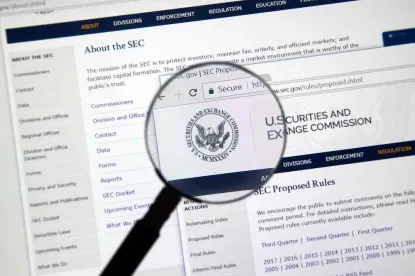On December 15, the SEC announced proposed changes to Securities Exchange Act Rule 10b5-1 that, if adopted, would significantly alter an important affirmative defense to insider trading charges brought by the SEC. The current version of the rule, which has been in effect since 2000, provides a means for corporate insiders to sell stock at predetermined intervals in order to avoid the presumption that their trades were made on the basis of material, nonpublic information, and thereby avoid liability under Section 10(b) of the Exchange Act and SEC Rule 10b-5.
The current and proposed versions of Rule 10b5-1 establish the circumstances under which an insider may be absolved of insider trading liability by providing evidence that they did not make trades on the basis of information obtained in breach of a fiduciary duty to their employer because the trades were predetermined by 1) a binding contract, 2) an instruction to another person to execute the trade, or 3) a written plan adopted when the insider was not aware of material nonpublic information.
The new conditions of proposed Rule 10b5-1 include:
-
Rule 10b5-1 trading arrangements entered into by corporate officers or directors must include a 120-day “cooling-off period” before any trading can commence under the trading arrangement after its adoption, including adoption of a modified trading arrangement
-
Rule 10b5-1 trading arrangements entered into by issuers must include a 30-day “cooling off period” before any trading can commence under the trading arrangement after its adoption, including adoption of a modified trading arrangement
-
Officers and directors must certify that they are not aware of material nonpublic information about the issuer or the security when adopting a new or modified trading arrangement
-
The affirmative defense under Rule 10b5-1(c)(1) does not apply to multiple overlapping Rule 10b5-1 trading arrangements for open market trades in the same class of securities
-
Rule 10b5-1 trading arrangements to execute a single trade are limited to one plan per 12-month period
-
Rule 10b5-1 trading arrangements must be entered into and operated in good faith
In addition, the proposed rule changes would require enhanced disclosure regarding Rule 10b5-1 trading arrangements, option grants, and issuer insider trading policies and procedures, including:
-
A requirement for an issuer to disclose in its annual report whether or not (and if not, why not) the issuer has adopted insider trading policies and procedures. Additionally, issuers would be required to disclose their insider trading policies and procedures, if they have adopted them.
-
A requirement for an issuer to disclose in its annual report its option grant policies and practices, and to provide tabular disclosure showing grants made within 14 days of the release of material nonpublic information and the market price of the underlying securities on the trading day before and after the release of such information.
-
A requirement for an issuer to disclose in its quarterly reports the adoption and termination of Rule 10b5 1 trading arrangements and other trading arrangements by directors, officers, and issuers, and the terms of such trading arrangements
-
A requirement that Section 16 officers and directors disclose by checking a box on SEC Forms 4 and 5 whether a reported transaction was made pursuant to a 10b5-1(c) trading arrangement
Interested parties may submit comments until 45 days after the proposed rule is published in the Federal Register.
According to one SEC commissioner, research conducted since the enactment of the initial version of the rule more than two decades ago supports the SEC’s proposed changes. Commissioner Caroline Crenshaw points to recent findings that purport to show there have been large concentrations of loss-avoiding trades by corporate executives using trading plans adopted within 60 days of an earnings announcement. Commissioner Crenshaw noted that, in light of these findings, the goal of the recently announced rule changes is to balance the liquidity needs of insiders with regulators’ duty to ensure a level playing field to protect investors.
The proposed changes would also make it easier for the SEC’s Enforcement Division to identify suspicious trades and to charge insiders with securities law violations above and beyond the underlying insider trading charge itself – which, in theory, will incentivize insiders not to skirt the rules. For example, requiring issuers to disclose whether they have adopted insider trading policies and procedures incentivizes officers and directors to ensure that the company has done so, and that such policies and procedures are enforced, lest the issuer be charged.
Similarly, imposing a 120-day cooling-off period on officers and directors would appear to deter abuse of Rule 10b5-1 trading plans because any undisclosed market event worth trading on presumably would have passed or changed before any nefarious trading under the plan could commence. All of this is to the good, of course, and should, in theory, prevent corporate insiders from using Rule 10b5-1 plans for illicit purposes. Whether it will do so in practice may take another two decades to determine.





 />i
/>i

